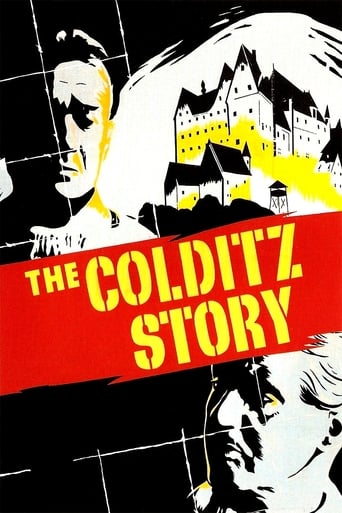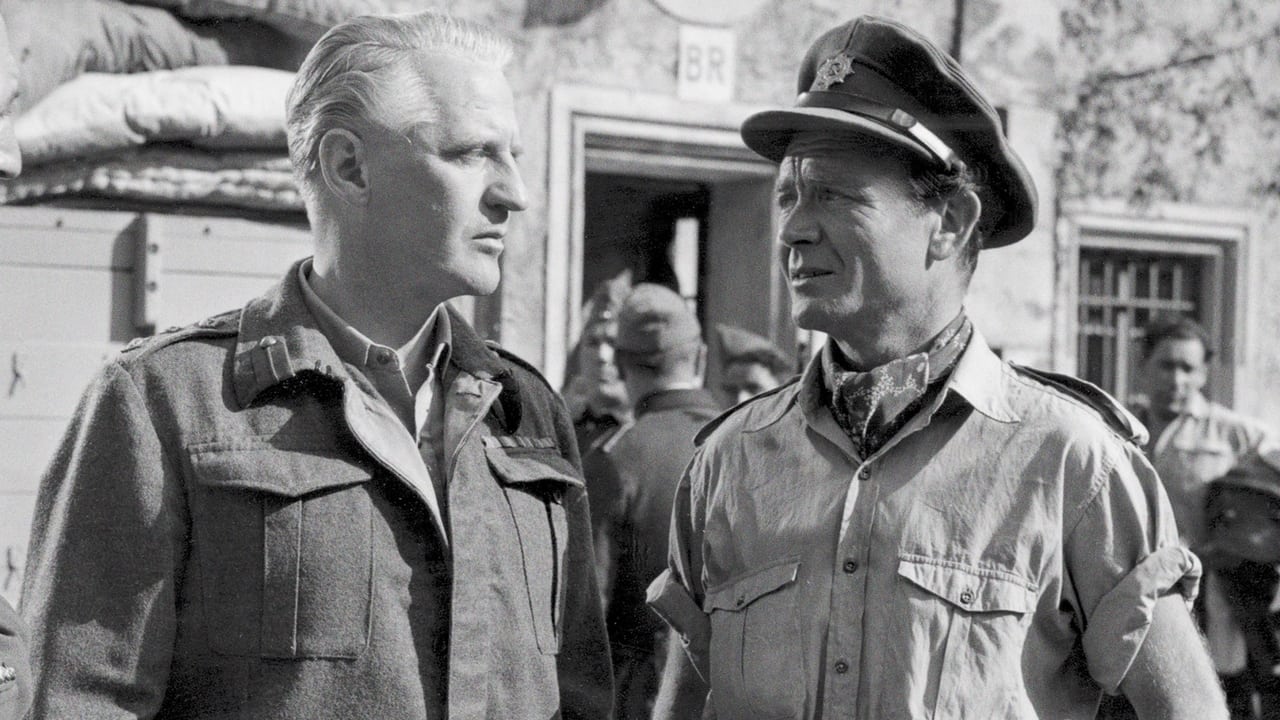SimonJack
This movie tells the story of Colditz Castle, the German POW camp (Oflag IV-C) for Allied officers who were escapees from other prisons during WW II. The Germans established Colditz as a maximum-security prison in 1939. It was supposed to be escape-proof. The guards outnumbered the prisoners. "The Colditz Story" is based on a book by British author Patrick Reid. He was one of 56 escapees who scored "home runs." They made it all the way back to their countries or Allied lines. The film condenses much of the book, and some of the characters are composites. But, all the events depicted in the film are true. The town and castle by the same name are located about 25 miles southeast of Leipzig in eastern Germany. The prison was just 40 miles from the Czech border and about 100 miles from Poland. The prison was opened in 1939 to hold Polish prisoners. By 1940, it was converted into the Allied officers prison. Other POWs soon arrived from England, Canada, Australia, New Zealand, Holland, Belgium and France. Late in the war, inmates were primarily British, and a handful of Americans arrived near the very end. Colditz was otherwise unusual for a German POW camp. It adhered strictly to the Geneva Convention in the treatment of prisoners. These were all officers who enjoyed comforts and privileges that no other prison camp afforded. The higher ranking officers actually had enlisted orderlies. This film barely touches on that. A later movie, "The Great Escape" told a greatly fictionalized story about the real escape from another POW camp, Stalag Luft III. That prison was run by the Luftwaffe (German air force) mostly for captured Allied pilots. It included a number who had escaped before. The conditions there were much inferior to those at Colditz. The first major film on German POW camp escapes, "Stalag 17" was made in 1953. It most accurately shows the conditions of the bulk of German POW camps and treatment of prisoners. The Colditz story is so interesting because of the concentration of escape-minded officers from so many countries. Those men were the epitome of the Allied prisoner code for attempting to escape. They tied down more German forces to maintain the prison, and then to hunt down escapees. These were all units and men that were kept from the German front lines. From its beginning until the liberation of Colditz by the U.S. Army in April 1945, POWs attempted about 320 escapes. That's about 60 per year. Of those, 130 made it out of the prison. And, an incredible 56 total were 'home runs." The French had the most successful escapes – 22. The Dutch had 15, the British 14 and the Poles had 5 prisoners who made it all the way to Allied lines. Colditz holds the record for most successful POW escapes in both world wars. John Mills plays Reid, the author and the only character from the book whose real name is used in the film. The rest of the cast are amalgams of other prisoners. The first British home run was Lt. Airey Neave in January 1942. The movie shows Reid as the first British escapee, but he wasn't. He served as the British escape officer and helped with many other escape attempts, including that of Neave and Dutch Lt. Tony Lewtegn. Christopher Rhodes plays Mac McGill in the film, a friend of Reid's. His character resembles Capt. Michael Sinclair who was the master of all escape artists. The Germans called the red-headed Brit the Red Fox and distributed his picture across Germany. Sinclair escaped nine times, including two times from Colditz. He was the only POW at Colditz who was killed trying to escape. The film shows how it happened when Mac climbs a fence and heads toward the forest. One other famous prisoner of Colditz isn't covered in the movie, and didn't succeed in an escape. But, Douglas Bader tried to escape and was there when the Americans liberated Colditz. Bader was a top British ace, with 23 scores. He was captured on Aug. 9, 1941, after a mid-air collision over France. He parachuted to the ground and his captors were amazed to see that Bader had no legs. Both of his artificial legs had been destroyed in his collision. After several attempts to escape from other locations, Bader was finally sent to Colditz.Besides Mills and Rhodes, several; other actors gave excellent performances in this film. Most notable among these was Eric Portman as Col. Richmond. Denis Shaw was a very good German Capt. Priem. And, Lionel Jeffries and Bryan Forbes have very good roles as Harry Tyler and Jimmy Winslow, respectively. This is a highly entertaining film. More than one reviewer found the humor too much or out of place. But, I think it fit well and was very believable. After all, humor is a balm for difficulties in life and trying times. Especially in the situation the POWs had in Colditz Castle, I suspect that the humor was very much like what the film shows. I highly recommend this film, and note that it's suitable for the whole family. Something rare, I think, for a wartime film.Viewers may also be interested to know that the first British Home Run from Colditz later served in Parliament. Airey Neave was an early friend, adviser and supporter of Margaret Thatcher. He was killed in a car bombing on March 30, 1979. A few weeks later, Margaret Thatcher became Prime Minister of Great Britain.
Chase_Witherspoon
Sir John Mills plays a POW who attempts to lead an escape crew out of the notorious high security German POW camp during WWII but the penultimate attempt is almost thwarted from within after the plan's conceiver (Rhodes) is dissuaded from participating by the British Colonel (Portman) due to his bulky frame. When Rhodes makes an opportunistic and futile attempt to escape, Mills feels compelled to stand down, but is persuaded by Portman to carry on regardless.Timid account bares similarities with "The Great Escape" made almost a decade later, most notably Rhodes vis-a-vis John Leyton's character. The tunnelling method used for the final escape attempt is also an obvious source of comparison but the daring and audacity in Colditz is more pronounced (during a vaudeville theatre show put on by the prisoners to distract the guards). Distinguished cast includes future comedians Ian Carmichael and Lionel Jeffries, as well as Bryan Forbes and Richard Wattis. Frederick Valk, who plays the German commandant has a few "Hogan's Heroes" moments with Portman and his corpulent watchman (Heller, who made a career of playing this type) which contributes to the film's sometimes casual tone, lacking tension and suspense.Satisfying conclusion and some well timed humour (the "my wife went to the West Indies of her own accord" gag still rates a chuckle) hit the high notes needed, and consequently, Colditz rates as a watchable if somewhat formula war-time prison escape fare.
Jackson Booth-Millard
Before The Great Escape, there was this Pow (Prisoner of War) escape film based on true events, from director Guy Hamilton (Goldfinger, Live and Let Die). The story sees many soldiers from Britain, France, Poland and other countries involved in World War II placed into Colditz castle, used by Nazis to hold the "bad boys", those who regularly attempted escape from other camps. There are more guards outnumbering the prisoners, and some were political with very strict monitoring. Anyway, the story sees Pat Reid (Sir John Mills) creating all sorts of escape routes and plans, including a tunnel, under the theatre stage, jumping over the fence, and dressing as Nazis, and these are what keep you interested. Also starring Eric Portman as Colonel Richmond, Christopher Rhodes as 'Mac' McGill, Lionel Jeffries as Harry Tyler,Frederick Valk as Kommandant, Bryan Forbes as Jimmy Winslow, Ian Carmichael as Robin Cartwright, Anton Diffring as Fischer and Ludwik Lawinski as Franz Josef. It was nominated the BAFTAs for Best British Film and Best Film from any Source. Sir John Mills was number 38 on The 50 Greatest British Actors, and the film was number 94 on The 100 Greatest War Films. Very good!
Peter Hayes
Allied prisoners - that normal prison of war camps can't hold - are sent to a mountain stronghold that they are told is "escape proof."Colditz Castle (in Germany) remains one of the most daunting and visited memorials of World War II. Looking a little like Count Dracula's castle from the outside the very sight of it must have made many a heart sink - especially those that didn't know if they were going to their deaths. Even when they found out that they weren't they still had to be vetted to see if they were not stool pigeons!This was originally a book and in the fullness of time it would be turned in to this film, a TV series (and a very good one at that) and even a hit board game. The film has to scrap a great deal of the (excellently written) book and can only represent a few of the many plot lines. In truth the prisoners ran out of escape ideas near the end and had only one left - to build a glider to escape from the roof. The war ended before it was tested!Anything with John Mills in is usually pretty good (ok - Who's That Girl, with Madonna falls short) and this is no exception. The prisoners realise that escape committee's are needed so escape attempts - between various nationalities - wouldn't cross one another. Everything here is based on a real incident, although some of the facts around it are fictionalised.A good memorial to a tough place and some tough people that were prepared to risk machine guns and attack dogs to get over-the-wall to continue the war. While this type of movie always has many dramatic plus points built in, it is - still - one the top hundred British movies ever made and one of my top two hundred (made anywhere) films. There isn't a second of boredom in the whole movie.



 AD
AD


